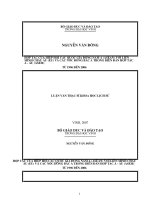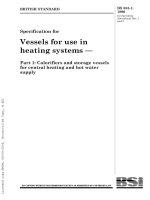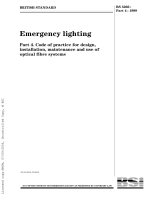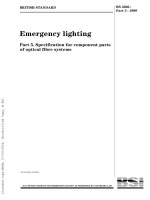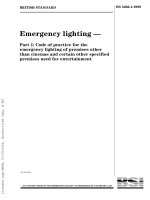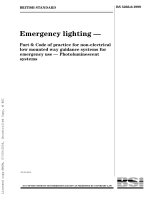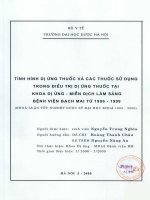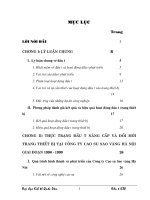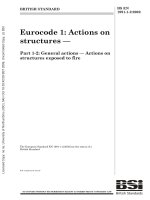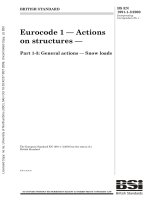Bsi bs au 209 6a 1996 (1999)
Bạn đang xem bản rút gọn của tài liệu. Xem và tải ngay bản đầy đủ của tài liệu tại đây (211.81 KB, 9 trang )
BRITISH STANDARD AUTOMOBILE SERIES
Vehicle security —
Part 6a: Specification for dead locking
systems for passenger cars and car
derived vehicles
Product code 00573968
BS AU 209-6a:
1 996
BS AU 209-6a:1 996
Committees responsible for this
British Standard
The preparation of this British Standard was entrusted to Technical
Committee AUE/1 7, Vehicle security, upon which the following bodies were
represented:
Association of Car Fleet Operators
Automobile Association
Automotive Glazing Executive
British Security Industry Association
Consumer Policy Committee of BSI
Consumer’s Association
Department of Trade and Industry (Vehicles Division)
Department of Transport
Freight Transport Association
Home Office
Ice (Ergonomics)
Master Locksmiths’ Association
Metropolitan Police
Motor Industry Research Association
Road Haulage Association Ltd.
Royal Automobile Club
Society of Motor Manufacturers and Traders Limited
This British Standard, having
been prepared under the
direction of the Engineering
Sector Board, was published
under the authority of the
Standards Board and comes
into effect on
1 5 January 1 996
© BSI 06- 1 999
The following BSI references
relate to the work on this
standard:
Committee reference AUE/1 7
Draft for comment 94/708975 DC
ISBN 0 5 80 24623 X
Amendments issued since publication
Amd. No.
Date
Comments
BS AU 209-6a:1 996
Contents
Page
Committees responsible
Foreword
ii
1
Scope
1
2
Normative references
1
3
Definitions
1
4
Performance
1
5
Test conditions
1
Annex A (normative) Power system tests
2
Annex B (normative) Inertia load test
2
Table A. 1 — Test sequence
2
List of references
© BSI 06- 1 999
Inside front cover
Inside back cover
i
BS AU 209-6a:1 996
Foreword
This Part of BS AU 209 has been prepared by Technical Committee AUE/1 7, at
the request of the Department of Transport and with the support of the Home
Office and organizations connected with law enforcement, the motor vehicle
construction industry and vehicle user organizations.
The provision of a dead locking system enhances the level of vehicle security
provided by the mechanical locking systems specified in BS AU 209- 1 a in
conj unction, as appropriate, with the central power locking systems specified in
BS AU 209- 5 by ensuring that even when the vehicle glazing is broken,
unauthorized entry is possible only by climbing through the glazing aperture.
Dead locking is therefore a considerable deterrent to a would- be thief.
This standard is not a substitute for anti- burst latch test requirements for vehicle
doors or for protective devices used on the steering system, transmission or gear
lever.
Other Parts of BS AU 209 are as follows:
— Part 0: Code of practice for the application of security devices/systems to
vehicles;
— Part 1 a: Specification for locking systems for passenger cars and car derived
vehicles;
— Part 2: Specification for security systems against theft of in-car equipment for
entertainment and communication purposes;
— Part 3: Specification for security marking of glazing for pasenger cars and
car derived vehicles;
— Part 4: Specification for security glazing for passenger cars and car derived
vehicles;
— Part 5b: Specification for central power locking systems for passenger cars
and car derived vehicles;
— Part 7: Specification for locking systems for goods vehicle driver’s
compartments.
It is envisaged that the following Parts will be published in due course.
— Part 8: Specification for locking systems for the load carrying compartment;
— Part 9: Specification for security of ancillary equipment on CVs;
— Part 1 0: Specification for immobilizers.
A British Standard does not purport to include all the necessary provisions of a
contract. Users of British Standards are responsible for their correct application.
Compliance with a British Standard does not of itself confer immunity
from legal obligations.
Summary of pages
This document comprises a front cover, an inside front cover, pages i and ii,
pages 1 and 2, an inside back cover and a back cover.
This standard has been updated (see copyright date) and may have had
amendments incorporated. This will be indicated in the amendment table on
the inside front cover.
ii
© BSI 06- 1 999
BS AU 209-6a:1 996
1 Scope
This Part of BS AU 209 specifies requirements for
the performance of dead locking systems fitted to
passenger compartment doors, luggage
compartment or hatchback doors, engine
compartment access, fuel filler aperture lids and
sun- roof equipment of passenger cars and car
derived vehicles.
This Part of BS AU 209 is intended to supplement
but not replace the requirements of Part 1 a and, for
a centrally locked system, Part 5b.
4.4 When the dead locking system is activated
either all internal closure controls shall free- wheel
or it shall not be possible to release any latch by:
a) the application of a steady force of (300 ± 1 0) N
for 5 s minimum in any direction on the
appropriate unlocking control; or
b) if the control normally operates in a rotational
movement, the application of a steady torque
of (50 ± 3) N · m for 5 s minimum in each
direction.
Where a mechanism is fractured or damaged as a
result of a) or b) , it shall be deemed to conform to
2 Normative references
This British Standard incorporates, by reference,
this Part of BS AU 209 provided that the
appropriate latches have not been released.
provisions from specific editions of other
4.5 It shall not be possible to lock a centrally
publications. These normative references are cited
powered dead locking system if:
at the appropriate points in the text and the
a) the statutory protective device has not been
publications are listed on the inside back cover.
activated, or set to activate;
Subsequent amendments to, or revisions of, any of
these publications apply to this British Standard
only when incorporated in it by updating or revision.
3 Definitions
For the purposes of this Part of BS AU 209 the
definitions given in Parts 1 a and 5b apply, together
with the following.
dead locking system
a system that renders the interior and exterior
controls of any closure inoperable other than by
operation of the system’s external lock(s)
b) the vehicle ignition, or the diesel equivalent, is
switched on;
c) all passenger and driver’s doors are fitted with
power- operated windows and one or more doors
are unlatched.
4.6 It shall not be possible for a single power
malfunction to cause dead locking of all the doors.
Compliance shall be checked by calculation. The
manufacturer shall maintain evidence that the
calculation method used simulates the results
obtained by the method described in Annex B.
4.7 The locking system shall be designed to ensure
that dead locking shall not be effective in the normal
4 Performance
4.1 The locking systems shall conform to
BS AU 209- 1 a and, for centrally locked systems,
BS AU 209- 5b in the locked modes.
4.2 The dead locking system shall be installed so
that entry to the passenger or luggage compartment
of the vehicle, either directly or via the engine
compartment, cannot be achieved by the use of
simple tools.
4.3 In order to activate the dead locking system the
external lock shall be operated with its own key or
remote unit. The external lock shall have either:
a) three conditions (unlocked, normal locked and
dead locked) where dead locking is a separate
deliberate action and is not an uninterrupted
continuation, under similar force levels, of the
action required to achieve normal locking; or
operating condition of the vehicle.
5 Test conditions
5 .1 For the tests specified in Annex A and Annex B,
a representative complete vehicle shall be provided
together with installation drawings of the system
applicable to the vehicle.
NOTE
Pre- test familiarization of the dead locking system by
examination of the vehicle and the drawings is permitted.
5 .2 Only those parts of the dead locking system that
have not been tested in accordance with
BS AU 209- 1 a and BS AU 209- 5b, including any
parts located within the engine compartment, shall
be tested in accordance with Annex A and Annex B.
5 .3 For tests carried out with the dead locking
system activated, all glazing, excluding security
glazing, giving access to the passenger
compartment shall be either broken or removed
b) two conditions (unlocked and dead locked)
except for the last 1 0 mm above the bottom of the
where only internal controls are provided for
daylight opening.
normal locking (i. e. anti- hij acking).
5 .4 Before the start of the tests all external closures
shall be fully closed and latched, and locked where
locks are provided.
© BSI 06- 1 999
1
BS AU 209-6a:1 996
Annex A (normative)
Power system tests
Annex B (normative)
Inertia load test
A.1 General
Apply an acceleration of (30
Power systems shall be tested in accordance
to a test vehicle or simulating structure
) for at least 30 ms
incorporating a representative total locking system
with A.2 or A.3 as appropriate.
NOTE
+6
0
The system may be isolated so as to protect non- security
installation as follows:
systems not under test.
a) in the forward and backward horizontal
A.2 Electrically powered systems
directions parallel to the longitudinal axis of the
Carry out the following tests. Each connection shall
vehicle;
b) in the inward and outward horizontal
be made for a duration of 2 s, replacing fuses as
directions perpendicular to the longitudinal axis
necessary before proceeding further:
of the vehicle;
a) connect each of the wires/connections to an
c) in the upward and downward vertical
earth on the vehicle;
directions.
b) connect in turn each wire/connection to the
The impact sensor, if fitted, shall be inoperative.
others, covering all possible combinations;
c) apply the normal supply voltage to each of the
wires/connections.
A.3 Systems powered other than by electrical
means
Apply consecutively to the system’s entry and
exhaust ports, and all other points accessible in
accordance with 4.2 , an external
pneumatic/hydraulic source of up to five times the
normal operating pressure, in both a positive sense
and, as far as it is possible, a negative sense.
For a normal operating pressure,
p,
conduct the
tests in accordance with the sequence of Table A. 1 .
Table A.1 — Test sequence
Test no.
1
Entry port
5
Exhaust port
0
2
p
2
3
0
– 5
5
p
0
4
p
0
– 5
p
© BSI 06- 1 999
BS AU 209-6a:1 996
List of references
(see clause 2 )
Normative references
BSI publications
BRITISH STANDARDS INSTITUION, London
BS AU 209, Vehicle security.
BS AU 209- la: 1 992, Specification for locking systems for passenger cars and car derived vehicles.
BS AU 209- 5b: 1 995, Specification for central power locking systems for passenger cars and car derived
vehicles.
Informative references
BSI publications
BRITISH STANDARDS INSTITUTION, London
BS AU 209, Vehicle security.
BS AU 209- 0: 1 995, Code of practice for the application of security devices/systems to vehicles.
BS AU 209- 2: 1 988, Specification for security systems against theft of in- car equipment for entertainment
and communication purposes.
BS AU 209- 3: 1 988, Specification for security marking of glazing for passenger cars and car derived vehicles.
BS AU 209- 4: 1 995, Specification for security glazing for passenger cars and car derived vehicles.
BS AU 209- 7: 1 993, Specification for locking systems for goods vehicle driver’s compartments.
BS AU 209- 8: 1 993, Specification for locking systems for the load carrying compartment
BS AU 209- 9: 1 993, Specification for security of ancillary equipment on CVs
BS AU 209- 1 0: 1 993, Specification for immobilizers
1)
It is envisaged that this Part will be published in due course.
© BSI 06- 1 999
1)
.
1)
.
1)
.
BS AU 209-6a:
1 996
BSI — British Standards Institution
BS I is the indep endent national b ody res p ons ib le for p rep aring
Britis h S tandards . It p res ents the UK view on s tandards in E urop e and at the
international level. It is incorp orated b y Royal C harter.
Revisions
Britis h S tandards are up dated b y amendment or revis ion. Us ers of
Britis h S tandards should make s ure that they p oss es s the latest amendments or
editions .
It is the constant aim of BS I to imp rove the quality of our p roducts and services .
We would b e grateful if anyone finding an inaccuracy or amb iguity while us ing
this Britis h S tandard would inform the S ecretary of the technical committee
res p ons ib le, the identity of which can b e found on the inside front cover.
Tel: 02 0 89 96 90 00. Fax: 02 0 89 96 7 40 0 .
BS I offers memb ers an individual up dating s ervice called PLUS which ens ures
that s ub s crib ers automatically receive the lates t editions of s tandards .
Buying standards
O rders for all BS I, international and foreign s tandards p ub lications s hould b e
addres s ed to C us tomer S ervices. Tel: 0 2 0 899 6 9 00 1 . Fax: 0 2 0 899 6 7001 .
In res p ons e to orders for international standards , it is BS I p olicy to sup p ly the
BS I imp lementation of thos e that have b een p ub lis hed as Britis h S tandards,
unless otherwis e requested.
Information on standards
BS I p rovides a wide range of information on national, E urop ean and
international standards through its Lib rary and its Technical H elp to E xp orters
S ervice. Various BS I electronic information s ervices are also availab le which give
details on all its p roducts and s ervices . C ontact the Information C entre.
Tel: 02 0 89 96 71 1 1 . Fax: 02 0 89 96 7 048.
S ub s crib ing memb ers of BS I are kep t up to date with s tandards develop ments
and receive sub s tantial discounts on the p urchase p rice of s tandards. For details
of thes e and other b enefits contact Memb ership Adminis tration.
Tel: 02 0 89 96 70 02 . Fax: 02 0 89 96 7 00 1 .
Copyright
C op yright s ub s is ts in all BS I p ub lications . BS I als o holds the cop yright, in the
UK, of the p ub lications of the internationalstandardization b odies . E xcep t as
p ermitted under the C op yright, D es igns and Patents Act 1 988 no extract may b e
rep roduced, s tored in a retrieval s ystem or transmitted in any form or b y any
means – electronic, p hotocop ying, recording or otherwis e – without p rior written
p ermis s ion from BS I.
This does not p reclude the free us e, in the cours e of imp lementing the standard,
of necess ary details such as s ymb ols, and size, typ e or grade designations. If thes e
details are to b e used for any other p urp os e than imp lementation then the p rior
written p ermiss ion of BS I must b e ob tained.
If p ermis sion is granted, the terms may include royalty p ayments or a licensing
agreement. D etails and advice can b e ob tained from the C op yright Manager.
BS I
3 89 C his wick H igh Road
London
W4 4AL
Tel: 02 0 89 96 70 7 0.
